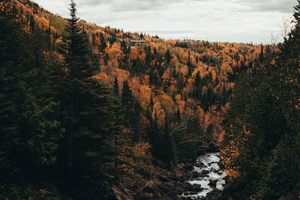About
It took one man more than 20 years to turn a large granite outcropping on the edge of Lake Kabetogama into an extensive series of terraced gardens, water pools and stone sculptures.
Not much is known about Jack Ellsworth. He and his wife Elsie lived in Chicago, he was a building contractor and a self-taught artist, and he owned a vacation property on the northern edge of Lake Kabetogama in St. Louis County, Minnesota.
Beyond that, we know he spent every summer between 1944 and 1965 creating the Ellsworth Rock Gardens at his vacation home, turning a large gray outcrop of rock into a lakeside wonderland of terraced gardens and rock sculptures. Why? Well, according to Jack in a rare recorded interview, his motivation was refreshingly straightforward: “We love this country and wish to spend more time here, but I just had to have something to keep me busy.”
And busy he certainly was. First he ferried building materials across the lake to build his cabin, outhouses and a shed. Then he set about creating his garden, using the irregular shape of the rock outcropping to inspire the garden's organic form. He planted more than 13,000 lilies in four varieties. He filled his terrace beds with about 32 herbaceous ornamental plant varieties, including dahlias, marigolds, phlox, nasturtiums, nicotiana, balsam and bachelor buttons, their brilliant colors contrasting with the native rock.
Ellsworth didn’t stop there. He added ponds and built stone bridges over natural water channels. He planted roses and peonies in beds near the base of the outcropping. And to top it all off, he constructed a system of some 200 stone sculptures of various shapes and sizes. Abstract shapes mixed with stone tables and altars; he built large monoliths and small stone spires, and stone gateways to show the direction of movement through the gardens.
The result was a fanciful rock garden surrounded by forested wilderness on one side, and the lake on the other: the kind of place you’d find the half-elven Arwen picking flowers for Aragorn.
Ellsworth’s work didn’t go unnoticed. Word soon spread and, during the garden’s heyday from the late-1940s to the mid-1960s, thousands of people came to visit each year. It became known as the “Showplace of Lake Kabetogama,” and people marveled at the work, the gardens seemingly having sprung spontaneously from the site, in harmony with the surrounding landscape.
In the 1960s, however, Ellsworth’s health began to decline. He made his final visit to the gardens in 1965, never to return. He died in 1974, and his wife a few years later.
The gardens began an almost two-decade period of decline. The basic form of the terraced beds remained, but some sculptures began to topple, and the forest slowly began to encroach upon the gardens. People still visited from across the lake, but not in the numbers of previous decades.
But the Lake Kabetogama community hadn’t forgotten about Ellsworth’s garden. Following the foundation of Voyageurs National Park in 1975, and the acquisition of the Ellsworth Rock Gardens by the National Park Service in 1978, locals put pressure on the park service to maintain the site. Finally, in 1996, a one-day vegetation removal effort took place. And, since 2000, the park has organized an annual tidying up of the site, known as the “Garden Blitz.”
The Ellsworth Rock Gardens have never returned to the splendor of their heyday, when Ellsworth himself was in charge. But, in some respects, the site has taken on a whole different kind of charm, like a mythological ruin where strange stone cats peer up at moss-covered monoliths, the whole thing arguably more in harmony with nature than ever before. Jack Ellsworth, one hopes, would approve.
Know Before You Go
The Ellsworth Rock Gardens are located in the northern shores of Lake Kabetogama in St. Louis County, Minnesota. You can only get there by boat. You can hire a local guide or tour agency to take you there, or check with the Voyageurs National Park for ranger-led boat tours (these were happening on Tuesdays during the summer, but check in advance to confirm). Entrance to the gardens is currently free, but there is a donations box on site, which helps with the ongoing restoration and maintenance efforts, which are largely carried out by volunteers.
Community Contributors
Added By
Published
January 15, 2019
Sources
- https://www.voyageurs.org/news/2018/6/8/jack-ellsworths-vision
- https://www.nps.gov/voya/learn/historyculture/ellsworth-rock-gardens.htm
- http://spacesarchives.org/explore/collection/environment/ellsworth-rock-gardens/
- https://explorationvacation.net/2016/06/ellsworth-rock-gardens-in-voyageurs-national-park-minnesota/
- http://www.drosteeffectmag.com/rock-garden-rocks-world/


















